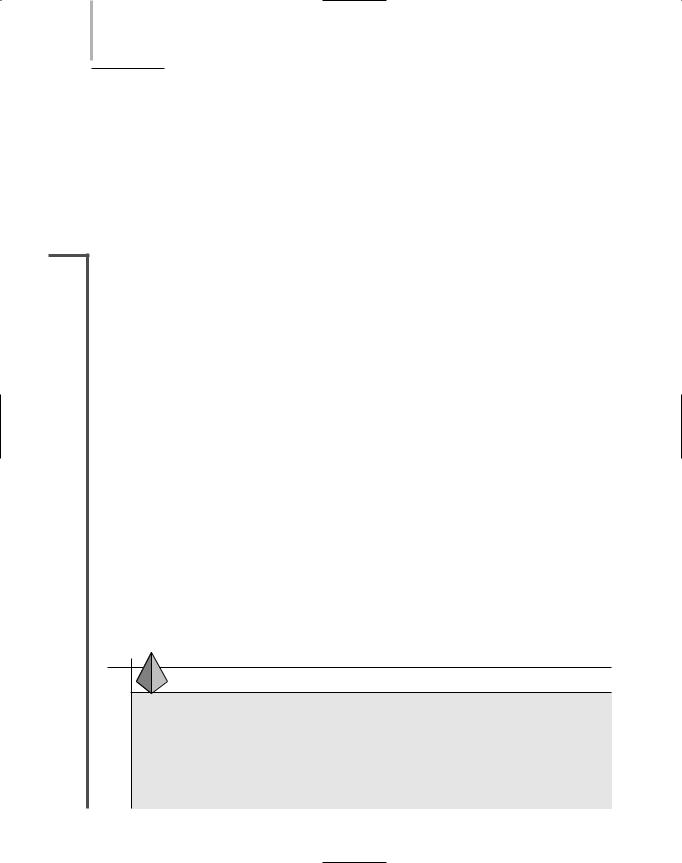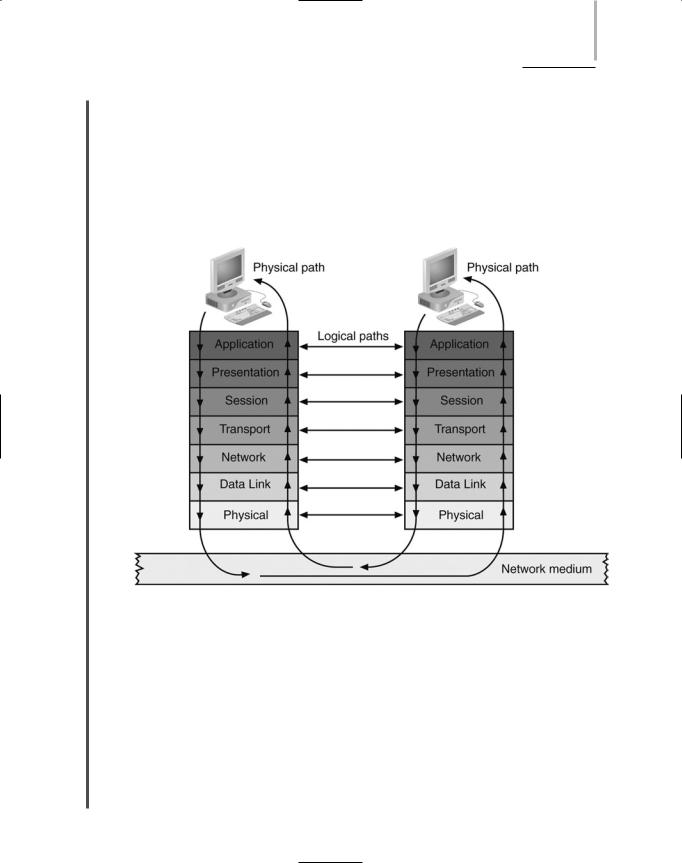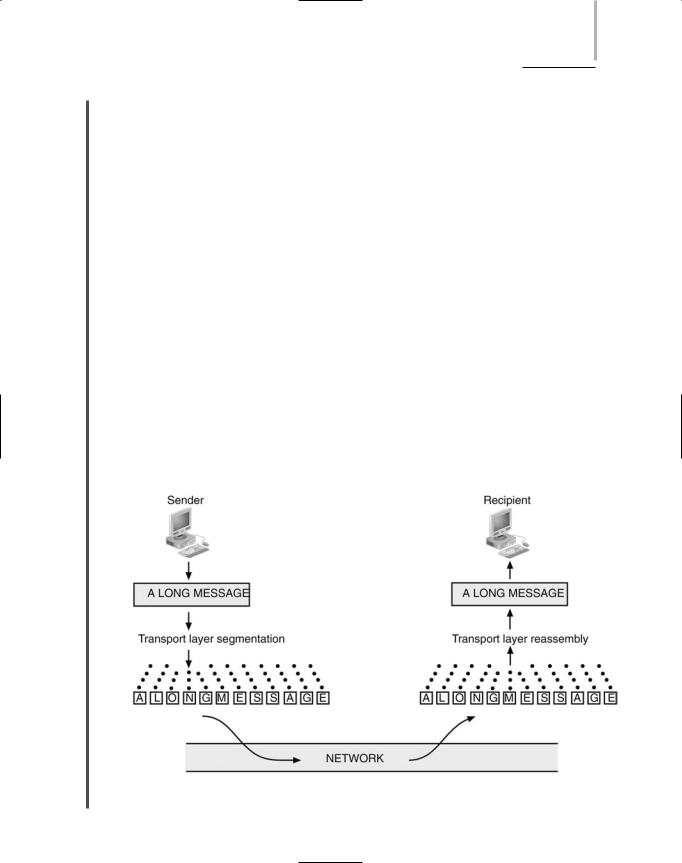
Network Plus 2005 In Depth
.pdf
When trying to grasp a new theoretical concept, it often helps to form a picture of that concept in your mind. In the field of chemistry, for example, even though you can’t see a water molecule, you can represent it with a simple drawing of two hydrogen atoms and one oxygen atom. Similarly, in the field of networking, even though you can’t see the communication that occurs between two nodes on a network, you can use a model to depict how the communication takes place. The model commonly used to describe network communications is
called the OSI (Open Systems Interconnection) Model.
In this chapter, you will learn about the standards organizations that have helped create the various conventions (such as the OSI Model) used in networking. Next, you’ll be introduced to the seven layers of the OSI Model and learn how they interact. You will then take a closer look at what goes on in each layer. Finally, you will learn to apply those details to a practical networking environment. Granted, learning the OSI Model is not the most exciting part of becoming a networking expert. Thoroughly understanding it, however, is essential to proficient network design and troubleshooting.
Networking Standards Organizations
Standards are documented agreements containing technical specifications or other precise criteria that stipulate how a particular product or service should be designed or performed. Many different industries use standards to ensure that products, processes, and services suit their purposes. Because of the wide variety of hardware and software in use today, standards are especially important in the world of networking. Without standards, it would be very difficult to design a network because you could not be certain that software or hardware from different manufacturers would work together. For example, if one manufacturer designed a network cable with a 1-centimeter-wide plug and another company manufactured a wall plate with a 0.8-cen- timeter-wide opening, you would not be able to insert the plug into the wall plate.
When purchasing networking equipment, therefore, you want to verify that equipment meets the standards your network requires. However, bear in mind that standards define the minimum acceptable performance of a product or service—not the ideal. So, for example, you might purchase two different network cables that comply with the minimum standard for transmitting at a certain speed, but one cable might exceed that standard, allowing for better network performance. In the case of network cables, exceeding minimum standards often follows from the use of quality materials and careful production techniques.
Because the computer industry grew so quickly out of several technical disciplines, many different organizations evolved to oversee its standards. In some cases, a few organizations are responsible for a single aspect of networking. For example, both ANSI and IEEE are involved

NETWORKING STANDARDS ORGANIZATIONS |
Chapter 2 |
33 |
in setting standards for wireless networks. Whereas ANSI prescribes the kind of NIC that the consumer needs to accept a wireless connection, IEEE prescribes, among other things, how the network will ensure that different parts of a communication sent through the atmosphere arrive at their destination in the correct sequence.
A complete list of the standards that regulate computers and networking would fill an encyclopedia. Although you don’t need to know the fine points of every standard, you should be familiar with the groups that set networking standards and the critical aspects of standards required by your network.
ANSI
ANSI (American National Standards Institute) is an organization composed of more than a thousand representatives from industry and government who together determine standards for the electronics industry and other fields, such as chemical and nuclear engineering, health and safety, and construction. ANSI also represents the United States in setting international standards. This organization does not dictate that manufacturers comply with its standards, but requests voluntarily compliance. Of course, manufacturers and developers benefit from compliance, because compliance assures potential customers that the systems are reliable and can be integrated with an existing infrastructure. New electronic equipment and methods must undergo rigorous testing to prove they are worthy of ANSI’s approval.
You can purchase ANSI standards documents online from ANSI’s Web site (www.ansi.org) or find them at a university or public library. You need not read complete ANSI standards to be a competent networking professional, but you should understand the breadth and significance of ANSI’s influence.
EIA and TIA
Two related standards organizations are EIA and TIA. EIA (Electronic Industries Alliance) is a trade organization composed of representatives from electronics manufacturing firms across the United States. EIA not only sets standards for its members, but also helps write ANSI standards and lobbies for legislation favorable to the growth of the computer and electronics industries.
In 1988, one of the EIA’s subgroups merged with the former United States Telecommunications Suppliers Association (USTSA) to form TIA (Telecommunications Industry Association). TIA focuses on standards for information technology, wireless, satellite, fiber optics, and telephone equipment. Both TIA and EIA set standards, lobby governments and industry, and sponsor conferences, exhibitions, and forums in their areas of interest.
Probably the best known standards to come from the TIA/EIA alliance are its guidelines for how network cable should be installed in commercial buildings, known as the “TIA/EIA 568- B Series.” You can find out more about TIA from its Web site: www.tiaonline.org and EIA from its Web site: www.eia.org.

34 |
Chapter 2 NETWORKING STANDARDS AND THE OSI MODEL |
IEEE
The IEEE (Institute of Electrical and Electronics Engineers), or “I-triple-E,” is an international society composed of engineering professionals. Its goals are to promote development and education in the electrical engineering and computer science fields. To this end, IEEE hosts numerous symposia, conferences, and local chapter meetings and publishes papers designed to educate members on technological advances. It also maintains a standards board that establishes its own standards for the electronics and computer industries and contributes to the work of other standards-setting bodies, such as ANSI.
IEEE technical papers and standards are highly respected in the networking profession. Among other places, you will find references to IEEE standards in the manuals that accompany NICs. You can purchase IEEE documents online from IEEE’s Web site (www.ieee.org) or find them in a university or public library.
ISO
ISO (International Organization for Standardization), headquartered in Geneva, Switzerland, is a collection of standards organizations representing 146 countries. ISO’s goal is to establish international technological standards to facilitate global exchange of information and barrier-free trade. Given the organization’s full name, you might expect it to be called “IOS,” but “ISO” is not meant to be an acronym. In fact, “iso” is the Greek word for “equal.” Using this term conveys the organization’s dedication to standards.
ISO’s authority is not limited to the information-processing and communications industries. It also applies to the fields of textiles, packaging, distribution of goods, energy production and utilization, shipbuilding, and banking and financial services. The universal agreements on screw threads, bank cards, and even the names for currencies are all products of ISO’s work. In fact, fewer than 300 of ISO’s more than 14,250 standards apply to computer-related products and functions. You can find out more about ISO at its Web site: www.iso.org.
ITU
The ITU (International Telecommunication Union) is a specialized United Nations agency that regulates international telecommunications, including radio and TV frequencies, satellite and telephony specifications, networking infrastructure, and tariffs applied to global communications. It also provides developing countries with technical expertise and equipment to advance those nations’ technological bases.
The ITU was founded in Paris in 1865. It became part of the United Nations in 1947 and relocated to Geneva, Switzerland. Its standards arm contains members from 189 countries and publishes detailed policy and standards documents that can be found on its Web site: www.itu.int. Typically, ITU documents pertain more to global telecommunications issues than to industry technical specifications. However, the ITU is deeply involved with the implementation of worldwide Internet services. As in other areas, the ITU cooperates with several different standards organizations, such as ISOC (discussed next), to develop these standards.

NETWORKING STANDARDS ORGANIZATIONS |
Chapter 2 |
35 |
ISOC
ISOC (Internet Society), founded in 1992, is a professional membership society that helps to establish technical standards for the Internet. Some current ISOC concerns include rapid growth, security, and the increased need for diverse services over the Internet. ISOC’s membership consists of thousands of Internet professionals and companies from over 180 countries.
ISOC oversees groups with specific missions, such as the IAB (Internet Architecture Board). IAB is a technical advisory group of researchers and technical professionals interested in overseeing the Internet’s design and management. As part of its charter, IAB is responsible for Internet growth and management strategy, resolution of technical disputes, and standards oversight.
Another ISOC group is the IETF (Internet Engineering Task Force), the organization that sets standards for how systems communicate over the Internet—in particular, how protocols operate and interact. Anyone can submit a proposed standard for IETF approval. The standard then undergoes elaborate review, testing, and approval processes. On an international level, IETF works with the ITU to help give technical standards approved in the United States international acceptance.
You can learn more about ISOC and its member organizations, IAB and IETF, at their Web site: www.isoc.org.
IANA and ICANN
You have learned that every computer on a network must have a unique address. On the Internet, this is especially important because millions of different computers must be available to transmit and receive data at any time. Addresses used to identify computers on the Internet and other TCP/IP-based networks are known as IP (Internet Protocol) addresses. To ensure that every Internet-connected device has a unique IP address, organizations across the globe rely on centralized authorities.
In early Internet history, a nonprofit group called the IANA (Internet Assigned Numbers Authority) kept records of available and reserved IP addresses and determined how addresses were doled out. Starting in 1997, IANA coordinated its efforts with three RIRs (Regional Internet Registries): ARIN (American Registry for Internet Numbers), APNIC (Asia Pacific Network Information Centre), and RIPE (Réseaux IP Européens). An RIR is a not-for-profit agency that manages the distribution of IP addresses to private and public entities. In the late 1990s, the U.S. Department of Commerce (DOC), which funded IANA, decided to overhaul IP addressing and domain name management. The DOC recommended the formation of
ICANN (Internet Corporation for Assigned Names and Numbers), a private, nonprofit corporation. ICANN is now ultimately responsible for IP addressing and domain name management. Technically speaking, however, IANA continues to perform the system administration.
Individuals and businesses do not typically obtain IP addresses directly from an RIR or IANA. Instead, they lease a group of addresses from their ISP (Internet Service Provider), a business that provides organizations and individuals with access to the Internet and often other services, such as e-mail and Web hosting. An ISP, in turn, arranges with its RIR for the right to

36 |
Chapter 2 NETWORKING STANDARDS AND THE OSI MODEL |
use certain IP addresses on its network. The RIR obtains its right to dole out those addresses from ICANN. In addition, the RIR coordinates with IANA to ensure that the addresses are associated with devices connected to the ISP’s network.
You can learn more about IANA and ICANN at their Web sites: www.iana.org and www.icann.org, respectively.
The OSI Model
NET+ |
In the early 1980s, ISO began work on a universal set of specifications that would enable com- |
2.2puter platforms across the world to communicate openly. The result was a helpful model for understanding and developing computer-to-computer communications over a network. This model, called the OSI (Open Systems Interconnection) Model, divides network communications into seven layers: Physical, Data Link, Network, Transport, Session, Presentation, and Application. At each layer, protocols perform services unique to that layer. While performing those services, the protocols also interact with protocols in the layers directly above and below. In addition, at the top of the OSI Model, Application layer protocols interact with the software you use (such an e-mail or spreadsheet program). At the bottom, Physical layer services act on the networking cables and connectors to issue and receive signals.
You have already learned that protocols are the rules by which computers communicate. A protocol is simply a set of instructions written by a programmer to perform a function or group of functions. Some protocols are included with a computer’s operating system. Others are files installed with software programs. Chapter 4 covers protocols in depth; however, some protocols are briefly introduced in the following sections to explain better what happens at each layer of the OSI Model.
The OSI Model is a theoretical representation of what happens between two nodes communicating on a network. It does not prescribe the type of hardware or software that should support each layer. Nor does it describe how software programs interact with other software programs or how software programs interact with humans. Every process that occurs during network communications can be associated with a layer of the OSI Model, so you should be familiar with the names of the layers and understand the key services and protocols that belong to each.
TIP
Networking professionals often devise a mnemonic way of remembering the seven layers of the OSI Model. One strategy is to make a sentence using words that begin with the same first letter of each layer, starting with either the lowest (Physical) or the highest (Application) layer. For example, you might choose to remember the phrase “Programmers Dare Not Throw Salty Pretzels Away.” Quirky phrases are often easiest to remember.

THE OSI MODEL |
Chapter 2 37 |
NET+ |
The path that data takes from one computer to another through the OSI Model is illustrated |
2.2in Figure 2-1. First, a user or device initiates a data exchange through the Application layer. The Application layer separates data into PDUs (protocol data units), or discrete amounts of data. From there, Application layer PDUs progress down through OSI Model layers 6, 5, 4, 3, 2, and 1 before being issued to the network medium—for example, the wire. The data traverses the network until it reaches the second computer’s Physical layer. Then at the receiving computer the data progresses up the OSI Model until it reaches the second computer’s Application layer. This transfer of information happens in milliseconds.
FIGURE 2-1 Flow of data through the OSI Model
Logically, however, each layer communicates with the same layer from one computer to another. In other words, the Application layer protocols on one computer exchange information with the Application layer protocols of the second computer. Protocols from other layers do not attempt to interpret Application layer data. In the following sections, the OSI Model layers are discussed from highest to lowest, beginning with the Application layer, where the flow of information is initiated.
Bear in mind that the OSI Model is a generalized and sometimes imperfect representation of network communication. In some cases, network functions can be associated with more than one layer of the model, and in other cases, network operations do not require services from every layer.

38 |
Chapter 2 NETWORKING STANDARDS AND THE OSI MODEL |
NET+ Application Layer
2.2The top, or seventh, layer of the OSI Model is the Application layer. Contrary to what its name implies, the Application layer does not include software applications, such as Microsoft Word or Netscape. Instead, Application layer services facilitate communication between software applications and lower-layer network services so that the network can interpret an application’s request and, in turn, the application can interpret data sent from the network. Through Application layer protocols, software applications negotiate their formatting, procedural, security, synchronization, and other requirements with the network.
For example, when you choose to open a Web page in Netscape, an Application layer protocol called HTTP (Hypertext Transfer Protocol) formats and sends your request from your client’s browser (a software application) to the server. It also formats and sends the Web server’s response back to your client’s browser.
Suppose you choose to view the Exhibits page at the Library of Congress’s Web site. You type “www.loc.gov/exhibits/index.html” in Netscape and press Enter. At that point Netscape’s API (application program interface), a set of routines that make up part of the software, transfers your request to the HTTP protocol. HTTP prompts lower-layer protocols to establish a connection between your computer and the Web server. Next, HTTP formats your request for the Web page and sends the request to the Web server. One part of the HTTP request would include a command that begins with “GET” and tells the server what page you want to retrieve. Other parts of the request would indicate what version of HTTP you’re using, what types of graphics and what language your browser can accept, and what browser version you’re using, among other things.
After receiving your computer’s HTTP request, the Web server responsible for www.loc.gov responds, also via HTTP. Its response includes the text and graphics that make up the Web page, plus specifications for the content contained in the page, the HTTP version used, the type of HTTP response, and the length of the page. However, if the Web page is unavailable, the host, www.loc.gov, would send an HTTP response containing an error message, such as “Error 404–File Not Found.”
After receiving the Web server’s response, your workstation uses HTTP to interpret this response so that Netscape can present the www.loc.gov/exhibits/index.html Web page in a format you’ll recognize, with neatly arranged text and images. Note that the information issued by one node’s HTTP protocol is designed to be interpreted by the other node’s HTTP protocol. However, as you will learn in later sections, HTTP requests could not traverse the network without the assistance of lower-layer protocols.
Presentation Layer
Protocols at the Presentation layer accept Application layer data and format it so that one type of application and host can understand data from another type of application and host. In other words, the Presentation layer serves as a translator. If you have spent any time working with computer graphics, you have probably heard of the GIF, JPG, and TIFF methods of compressing and encoding graphics. MPEG and QuickTime are two popular methods of

THE OSI MODEL |
Chapter 2 39 |
NET+ |
compressing and encoding audio and video data. Two well-known methods of encoding text |
2.2are ASCII and EBCDIC. In each of these examples, it is the Presentation layer protocols that perform the coding and compression. They also interpret coded and compressed formats in data received from other computers. In the previous example of requesting a Web page, the Presentation layer protocols would interpret the JPG files transmitted within the Web server’s HTTP response.
Presentation layer services also manage data encryption (such as the scrambling of passwords) and decryption. For example, if you look up your bank account status via the Internet, you are using a secure connection, and Presentation layer protocols will encrypt your account data before it is transmitted. On your end of the network, the Presentation layer will decrypt the data as it is received.
Session Layer
Protocols in the Session layer coordinate and maintain communications between two nodes on the network. The term session refers to a connection for ongoing data exchange between two parties. Historically, it was used in the context of terminal and mainframe communications, in which the terminal is a device with little (if any) of its own processing or disk capacity that depends on a host to supply it with software and processing services. Today, the term session is often used in the context of a connection between a remote client and an access server or between a Web browser client and a Web server.
Among the Session layer’s functions are establishing and keeping alive the communications link for the duration of the session, keeping the communication secure, synchronizing the dialog between the two nodes, determining whether communications have been cut off, and, if so, figuring out where to restart transmission, and terminating communications. Session layer services also set the terms of communication by deciding which node will communicate first and how long a node can communicate. Finally, the Session layer monitors the identification of session participants, ensuring that only the authorized nodes can access the session.
When you dial your ISP to connect to the Internet, for example, the Session layer services at your ISP’s server and on your computer negotiate the connection. If your phone line accidentally falls out of the wall jack, Session layer protocols on your end will detect the loss of a connection and initiate attempts to reconnect. If they cannot reconnect after a certain period of time, they will close the session and inform your dial-up software that communication has ended.
Transport Layer
Protocols in the Transport layer accept data from the Session layer and manage end-to-end delivery of data. That means they can ensure that the data is transferred from point A to point B reliably, in the correct sequence, and without errors. Without Transport layer services, data could not be verified or interpreted by its recipient. Transport layer protocols also handle flow control, which is the process of gauging the appropriate rate of transmission based on how fast the recipient can accept data. Dozens of different Transport layer protocols exist, but most

40 |
|
|
Chapter 2 NETWORKING STANDARDS AND THE OSI MODEL |
|
|
||||
|
|
|
|
|
|
|
modern networks, such as the Internet, rely on only a few. In the example of retrieving a Web |
||
NET+ |
|
|
||
2.2page, a Transport layer protocol called the Transmission Control Protocol (TCP) takes care of reliably transmitting the HTTP protocol’s request from client to server and vice versa. You will learn more about this significant protocol later in this book.
Some Transport layer protocols take steps to ensure that data arrives exactly as it was sent. Such protocols are known as connection-oriented, because they establish a connection with another node before they begin transmitting data. TCP is one example of a connection-ori- ented protocol. In the case of requesting a Web page, the client’s TCP protocol first sends a SYN (synchronization) packet request for a connection to the Web server. The Web server responds with a SYN-ACK (synchronization-acknowledgment) packet, or a confirmation, to indicate that it’s willing to make a connection. Then, the client responds with its own ACK (acknowledgment). Through this three-step process a connection is established. Only after TCP establishes this connection does it transmit the HTTP request for a Web page.
Acknowledgments are also used in subsequent communications to ensure that data was properly delivered. For every data unit a node sends, its connection-oriented protocol expects an acknowledgment from the recipient. For example, after a client’s TCP protocol issued an HTTP request, it would expect to receive an acknowledgment from the Web server proving that the data arrived. If data isn’t acknowledged within a given time period, the client’s protocol assumes the data was lost and retransmits it.
To ensure data integrity further, connection-oriented protocols such as TCP use a checksum. A checksum is a unique character string that allows the receiving node to determine if an arriving data unit matches exactly the data unit sent by the source. Checksums are added to data at the source and verified at the destination. If at the destination a checksum doesn’t match what the source predicted, the destination’s Transport layer protocols ask the source to retransmit the data. As you will learn, protocols at other layers of the OSI Model also use checksums.
Not all Transport layer protocols are concerned with reliability. Those that do not establish a connection before transmitting and make no effort to ensure that data is delivered error-free are called connectionless protocols. A connectionless protocol’s lack of sophistication makes it more efficient than a connection-oriented protocol and renders it useful in situations in which data must be transferred quickly, such as live audio or video transmissions over the Internet. In these cases, connection-oriented protocols—with their acknowledgments, checksums, and flow control mechanisms—would add overhead to the transmission and potentially bog it down. In a video transmission, for example, this could result in pictures that are incomplete or don’t update quickly enough to coincide with the audio.
In addition to ensuring reliable data delivery, Transport layer protocols break large data units received from the Session layer into multiple smaller units, called segments. This process is known as segmentation. On certain types of networks, segmentation increases data transmission efficiency. In some cases, segmentation is necessary for data units to match a network’s MTU (maximum transmission unit), the largest data unit it will carry. Every network type specifies a default MTU (though its size can be modified to some extent by a network administrator). For example, by default, Ethernet networks cannot accept packets with data payloads larger than 1500 bytes. Suppose an application wants to send a 6000-byte unit of data. Before

THE OSI MODEL |
Chapter 2 41 |
NET+ |
this data unit can be issued to an Ethernet network, it must be segmented into units no larger |
2.2than 1500 bytes. To learn a network’s MTU size (and thereby determine whether it needs to segment packets), Transport layer protocols perform a discovery routine upon establishing a connection with the network. Thereafter, the protocols will segment each data unit as necessary until closing the connection.
Segmentation is similar to the process of breaking down words into recognizable syllables that a child uses when learning to read. Reassembly is the process of reconstructing the segmented data units. To continue the reading analogy, when a child understands the separate syllables, he can combine them into a word—that is, he can reassemble the parts into a whole. To learn how reassembly works, suppose that you asked this question in history class: “Ms. Jones? How did poor farming techniques contribute to the Dust Bowl?” but that the words arrived at Ms. Jones’s ear as “poor farming techniques Ms. Jones? how did to the Dust Bowl? contribute.” On a network, the Transport layer recognizes this kind of disorder and rearranges the data pieces so that they make sense.
Sequencing is a method of identifying segments that belong to the same group of subdivided data. Sequencing also indicates where a unit of data begins, as well as the order in which groups of data were issued, and therefore should be interpreted. While establishing a connection, the Transport layer protocols from two devices agree on certain parameters of their communication, including a sequencing scheme. For sequencing to work properly, the Transport layer protocols of two nodes must synchronize their timing and agree on a starting point for the transmission.
Figure 2-2 illustrates the concept of segmentation and reassembly.
FIGURE 2-2 Segmentation and reassembly
